Boxer
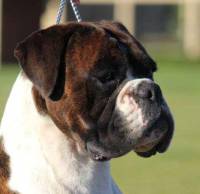 Boxer
Boxer
The Boxer is one of our most popular and easily recognisable pure breed dogs. His unique head, balance, clean cut body lines, proud and noble carriage, personality and sense of humour stamp the Boxer into the memory of all who meet him. German in origin, he has been developed slightly differently in various countries throughout the world where he has been owned and bred by many prominent dog people. But as this is an Australian website, the description of the Boxer published here is based on the Breed Standard used in this country.
History of the Boxer
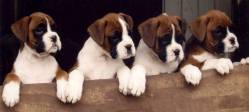 Boxer Pups
Boxer Pups
In a similar way to how the Bulldog developed from the early Mastiffs in Britain to produce a butcher's assistant, the Boxer developed in Germany for the same purpose. However, the Boxer was developed from a large German Mastiff dog called the Bullenbeisser.
 German Mastiffs c 1780
German Mastiffs c 1780
Throughout the middle ages the Bullenbeisser was Germany's only hunting hound[3]. It hunted the wild beasts alone, instead of in packs like the hounds of England. One Bullenbeisser would tackle the game head on, holding it with such a grip that the dog was kept from injury for sufficient time for the hunters to reach the game and kill it.
As the centuries rolled by, the large estates were broken up, and hunting game for sport was no longer popular. Consequently a smaller type of Bullenbeisser became the butcher's assistant in a similar way to the early development of the British Bulldog of England, with its undershot jaw holding the game by the nose.
By about 1880 then, the Bullenbeisser had lost his aristocratic connections and had become a butcher's dog, useful around slaughter houses for rounding up cattle and popular with students and actors for his tractability and good disposition. His undershot jaw gave so strong a grip that he was often unable to let go.[1]
The Boxer becomes a Pure Bred
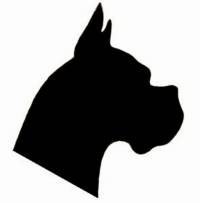 Boxer Munich Silhouette (note cropped ears were permissable at that time)
Boxer Munich Silhouette (note cropped ears were permissable at that time)
Although the Boxer and the British Bulldog obviously came from the same family, they developed in differently in different countries. The next two centuries would see what was regarded as ugly characteristics, bred out without sacrificing temperament. Consequently, prior to 1870 the Germans had already produced a noble, well balanced, agile type of dog.
In 1894, when a German man named Friedrich Roberth, traveled home to Munich, he witnessed that a smaller type of Bullenbeisser than those he had encountered in his youth. He wanted to develop it into a more elegant dog. Others joined him in his passion with the result in 1895 they lobbied for a class to held in a Show in Munich. The only entry was a dog named "Flocki", However, this attracted so much interest that on January 17, 1896 "Der Deutscher Boxer Club" was formed. Not only did "Flocki" become the number one dog in the Stud Book, they they decided to name the breed 'Boxer'. At first the name was meant to be a joke because this dog used its front feet like a boxer! But the name stuck!
On March 29, 1896 the world's first Boxer Specialist Championship Show was held. It attracted around 20 exhibits. Then, a group of enthusiasts met to produce a Breed Standard. By eliminating 'Bulldoggy' characteristics, the focus was to create a powerful dog that was noble and agile[5]. The outline of the head as depicted on the Munich Silhouette (pictured) became the hallmark of the breed symbolizing the Boxer as an individual pure breed.
 Tirkane Daybreak Jewel
Tirkane Daybreak Jewel
History of Boxers in Australia
 Tirkane Tony
Tirkane Tony
The initial importations of Boxers into Victoria were from Ireland purchased by the well known judge Mr H.(Fred) Wheatland. These were 'Tirkane Tony', 'Tirkane Daybreak Jewel' and 'Tirkane Taffeta'. All 3 were exhibited at the Royal Melbourne Show in 1948[4], with 'Tirkane Daybreak Jewel' winning Best Boxer.
The following year, the colourful personalities Harold ('Skipper') and Stella Taylor imported a dog 'Gremlin Sundago' from England followed by two puppies, 'Gremlin Hillsong' and 'Gremlin Snowboots'. They bred their first Champions with these and then imported another 8 from UK.
 Boxer (Australia) c 1950
Boxer (Australia) c 1950
The most famous of these was English Champion Panfield Zest (pictured). This dog certainly put Boxers on the map here by not only by his amazing showmanship which won him Best in Show at several of our major 'Royals', but also by stamping his breed type on Boxers throughout Australia[2].
From these early times, many prominent Australian dog personalities imported, bred and showed Boxers, ensuring their place in Australia's dog world. Today, not only rarely does a Show takes place without a quality Boxer competing for the highest awards, the Boxer is well known throughout this country as an easy-to-care-for and reliable family pet.
The Boxer Today
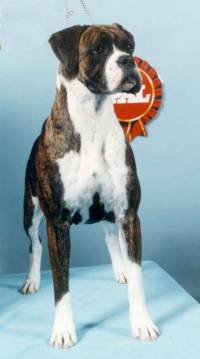 Boxer (Brindle and White)
Boxer (Brindle and White)
The Boxer is an athletic, squarely-built brachycephalic breed with substance, elegance, nobility and a unique head. Medium sized and clean in outline, he stands 53 - 61 cms (21-24 inches) tall and weighs 28-30 kilos (62-66 pounds). He comes in fawn or brindle with or without attractive white markings which, when placed on the head, should not obliterate his essential black mask.
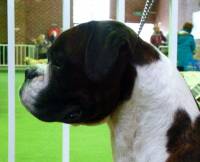 Boxer Head
Boxer Head
His head is unique because of the outline of the muzzle formed by the clean lips and slightly upturned nose. The skull is slightly arched but not overdone in length caused by a too prominent occiput, or width caused by excessive development of cheek muscles. Instead the skull must be in balance with the whole body and the length of the muzzle to the whole of the head should be 1:3. The shallow furrow running down the skull ends with a definite stop. The black nose should be broad and be set slightly above the level of the foreface as shown in the Munich Silhouette on the left. The historical function of this strong wide muzzle with its definite chin and undershot mouth was to give the dog its grip. The lower edge of the thick, padded upper lip rests upon the lower lip completing the unique outline of the muzzle. The medium sized eyes must have a dark rim. The moderate sized ears have thin texture, lie flat and close to the cheek and are set wide apart on the skull. Some countries outside Australia permit the cropping of Boxer's ears.
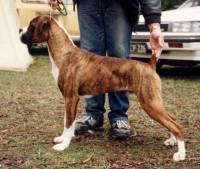 Young Boxer
Young Boxer
The body in profile, begins at the neck the arched shape of which gives the dog its elegant look. The neck's ample length with lack of dewlap (cleanliness) and arch, runs into clearly defined withers. The short, straight, strong and muscular back finishing with a slightly sloping flat, broad croup and gaily carried high-set tail, completes the square look of the body. The depth of chest should be half the height of the dog and the underline should curve to the rear.
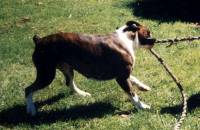 Boxer
Boxer
Looking over the dog, the shoulders should not be excessively muscled and the ribs should be well arched but not barrel-shaped. Viewed from the front, the trunk-like forelegs should be straight and parallel, the pasterns short but slightly sloping and the cat-like feet should also be small with tightly arched toes. The hindquarters should be so strongly muscled that the muscles should look like they stand out through the skin as though they were made of plastic. The first and second thighs and long, with the short hock or rear pastern not completely vertical when viewed in profile. He moves with elasticity and energy and carries himself with pride and nobility.
Comparison between the Boxer and the Bullmastiff
Like the Bullmastiff, the Boxer is a brachycephalic breed with the black masked muzzle measuring one third of the skull. Although the Boxer is overall a much lighter and more elegantly built dog than the Bullmastiff, these two breeds are often confused. For this reason, their main differences are presented here as a comparison.
| Boxer | Bullmastiff | |
|---|---|---|
| Country of origin | Germany | England |
| Size | Stands 53 - 61 cms (21-24 inches) tall and weighs 28-30 kilos (62-66 pounds) | Stands up to 61-69 cms tall (24-27 inches) tall and weighs 41-59 kilos to (90-130 pounds) |
| Colour | Fawn, brindle and fawn in various shades with or without white markings but always with the essential black mask | Fawn, brindle or red, with a black muzzle toning off towards the eyes |
 Boxer Boxer |
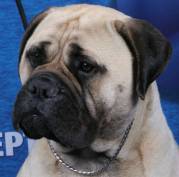 Bullmastiff Bullmastiff |
|
| Head | The nose is slightly turned up showing a distinct chin which causes his undershot mouth | The muzzle should form a right angle to the upper line of the face so the mouth is only slightly undershot. |
| Neck | Of ample length, the marked arch flowing into the shoulders and clean throat responsible for the Boxer's elegance | Moderate length and almost equal in circumference to the skull |
| Forequarters | Chest half the height of the dog at the clearly defined withers, trunk like forelegs with slightly sloping pasterns | Chest wide with deep brisket and powerful forelegs with straight strong pasterns |
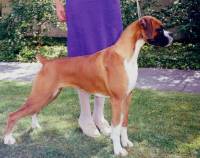 Boxer Boxer |
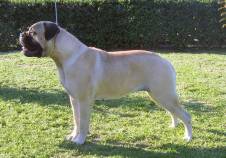 Bullmastiff (Fawn) Bullmastiff (Fawn) |
|
| Body | Short, straight, strong and muscular with a square profile finishing with a slightly sloping flat, broad croup and gaily carried high-set tail. The underline should have an elegant curve | Compact in carriage, his wide muscular loins giving him a fairly deep flank and a firm but level topline |
| Hindquarters | The muscles in the back legs should look so powerful that they look like plastic through the skin. The long first and send thighs are so well angulated that the hock is not quite vertical | Wide, strong and muscular with well developed second thighs but moderate angulation |
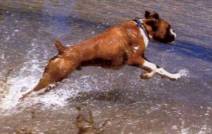 Boxer Boxer |
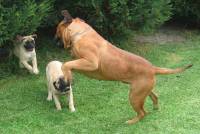 Bullmastiff with Pups Bullmastiff with Pups |
|
| Feet | Small and cat-like | Cat-like with dark nails |
| Tail | Set on high and carried gaily, upwards when docking is allowed. However, the docking of Boxer's tails is now prohibited in Australia | His tail is thick at the root and tapering so it reaches the hock but it should not be carried above the level of the topline except when excited or moving |
| Gait | Elastic with energy and carrying himself with pride and nobility. | Balanced and harmonious with good thrust from the rear |
References and Further Reading
[1] Milo D Denlinger, - 'The Complete Boxer' Third Edition Published by Denlingers, Middleburg, Virginia USA 1958 Chapter 2 Early Boxer History Pages 13 - 19
[2] Faye Crooks, - 'The History of Boxers in Victoria - 1947 - 2004' Officers and Committee of the Boxer Association of Victoria 2004, Laburnum Victoria 3036 ISBN 9-780646-441405 Page 6- 10. We thank Faye for her assistance with this page.
2019 - Book Review - Jane Harvey - 'The History of Boxers in Victoria 1947 - 2004 by Faye Crooks in conjunction with the Boxer Club of Victoria published in 'VicDog Magazine' (Victorian Canine Association Inc., Melbourne) Vol 86 February 2019 February No 2 Page 16
- Also published in Dog News Australia (Top Dog Media Pty Ltd Austral NSW) Issue 1 January 2019, Page 6
[3] John P Wagner, - 'The Boxer' Published by Orange Judd Publishing Company Inc 1956 Chapter 2 Page 18
[4] Catalogue Royal Melbourne Show 1948, 17th - 26th September Published by the Royal Agricultural Society of Victoria Page 529
[5] Dan M Gordon, M.D. 'The Boxer' Published 1951 by Judy Publishing Company Chapter Two 'Historical Aspects of the Boxer in Germany Pages 13 - 14.